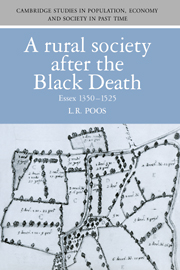Book contents
- Frontmatter
- Contents
- List of figures
- List of tables
- Preface
- Abbreviations
- Part I Reflections on a transitional era
- Part II ‘Country-dwellers, common folk and craftsmen’
- 1 People, land and occupations
- 2 Geography of a local economy
- 3 The rural cloth industry
- 4 Houses
- Part III ‘The total sum of all persons’
- Part IV ‘While it is so forward between us’
- Part V ‘She came that day seeking service’
- Part VI ‘Beware of such holy men’
- Part VII Synthesis
- Bibliography
- Index
- Cambridge Studies in Population, Economy and Society in Past Time 18
2 - Geography of a local economy
Published online by Cambridge University Press: 14 September 2009
- Frontmatter
- Contents
- List of figures
- List of tables
- Preface
- Abbreviations
- Part I Reflections on a transitional era
- Part II ‘Country-dwellers, common folk and craftsmen’
- 1 People, land and occupations
- 2 Geography of a local economy
- 3 The rural cloth industry
- 4 Houses
- Part III ‘The total sum of all persons’
- Part IV ‘While it is so forward between us’
- Part V ‘She came that day seeking service’
- Part VI ‘Beware of such holy men’
- Part VII Synthesis
- Bibliography
- Index
- Cambridge Studies in Population, Economy and Society in Past Time 18
Summary
To examine its people in terms of occupational structures or economic layers is to consider only one dimension of the district. It is also necessary to examine how people fitted into the spaces they inhabited. The great majority of Essex people in the later middle ages lived in small rural communities, containing no more than 200 souls, and the great majority worked in agriculture for part or all of the year. But even within the fairly close confines of a single county, there were wide variations in the density of settlement and the sizes, forms and functions of communities. These patterns in turn hold clues to understanding spatial variations in agriculture, influences of markets (including the largest market in all of England, the city of London), and the distribution of industrial and other non-agricultural activities. Industry – specifically, the district's most important rural industry, clothmaking – and its geography will be considered in more detail in the next chapter. But the district's general human and economic geography must first be examined.
In 1377, when the returns of the first poll tax permit a reasonably reliable picture to be sketched of relative population densities in different parts of the country, Essex ranked roughly only at the median among English counties in recorded settlement density. But county-wide averages can conceal many contrasts at more local levels. Figure 2.1 maps densities of taxpayers per square mile on a township-by-township basis from the 1377 taxation in Essex in order to demonstrate this point.
- Type
- Chapter
- Information
- A Rural Society after the Black DeathEssex 1350–1525, pp. 32 - 57Publisher: Cambridge University PressPrint publication year: 1991

